Pad Kee Mao Recipe is made with wide rice noodles, vegetables, basil leaves, and chicken or shrimp with a mixture of sauces. For this recipe, I have used zucchini, peppers and shrimp which are stir-fried with the noodles in a homemade spice mixture and a blend of sauces!
Pad Kee Mao recipe is popularly known as “drunken noodles” in Thailand. I’ve heard that these noodles are made so hot that people usually have an alcoholic drink while eating them. The noodles are not made with any alcohol whatsoever.
Noodles of any cuisine are some of my favorite dishes, especially fried noodles. Thai food appeals to me because of their equilibrium of sweet, sour, and heat to give their dishes a balance. My past trips to Thailand’s capital city, Bangkok, have intrigued me with its delectable cuisine. I have had the chance to wander through the streets of Bangkok where I have savored street vendors customizing the noodles for you.
Having had enough experience making Malaysian cuisine, it has been relatively easy for me to latch on to Thai cooking for many years. Some of our favorite Thai restaurants that serve Pad Kee Mao have used a variety of vegetables and shrimp in their recipe. I have elected to use shrimp because I think that it adds more flavor to the noodles when paired with Thai basil which enhances the flavor.
Frequently Asked Questions:
- What is the difference between Pad Kee Mao recipe and Pad Thai?
Pad Kee Mao translates to “drunken noodles” which is usually enjoyed during a night of drinking, while Pad Thai is more well-known and translates to “Thai stir-frying”. Pad Kee Mao is spicier and has a savory profile while Pad Thai is both sweet and sour made with tamarind, beansprouts, and peanuts.
2. How can I make this Pad Kee Mao recipe vegetarian?
You can skip adding shrimp but would recommend adding other veggies such as carrots and broccoli florets. Sometimes, I garnish the noodles with Chinese cabbage strips after cooking.
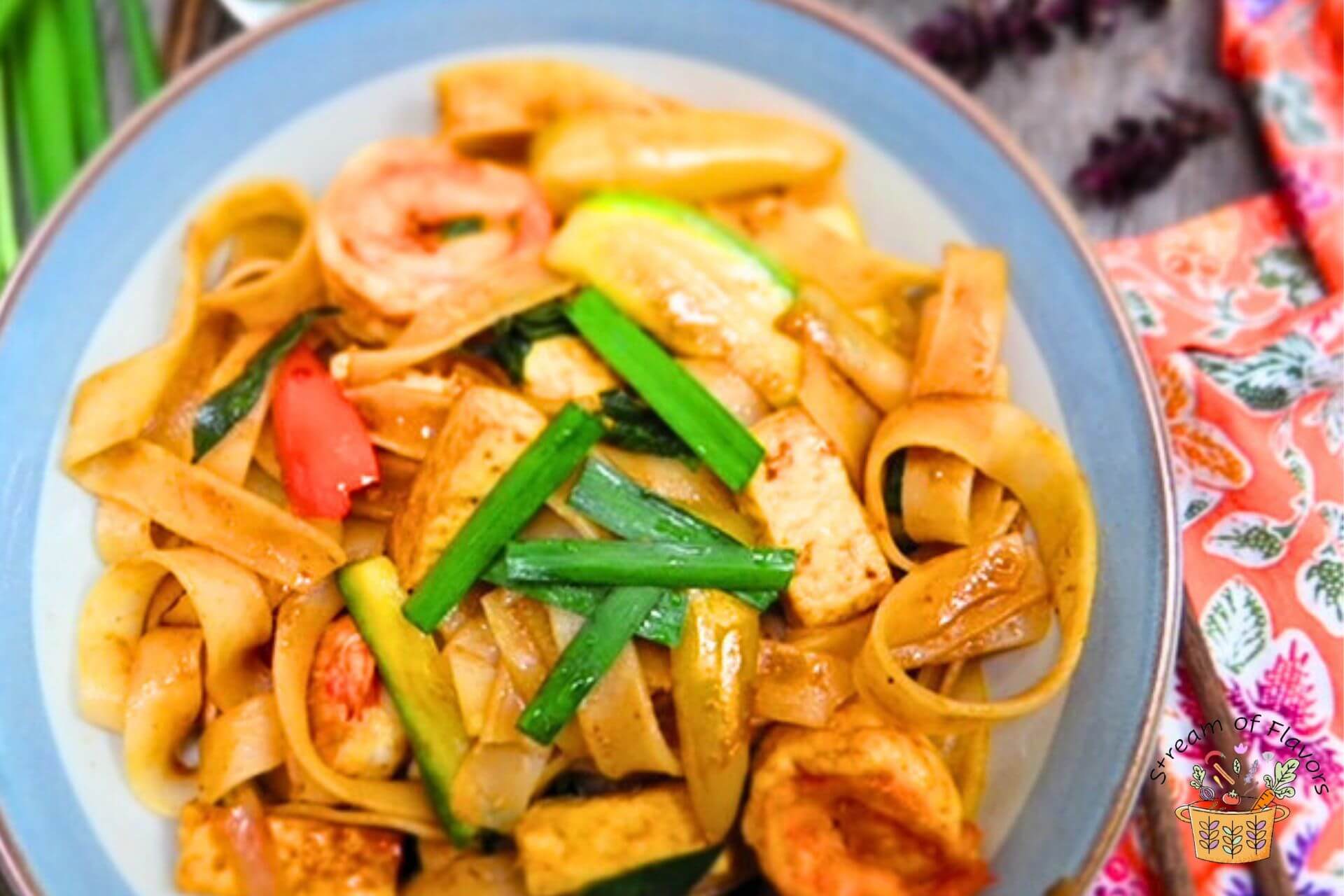
Ingredients:
- Noodles: wide flat rice noodles
- Thai basil or Thai Holy Basil: The Italian basil or the Indian Holy basil will not work for this dish but you could use the Italian one if you absolutely cannot find the Thai variety.
- Thai chilis: If you like your dish mild, then lower the spice index a notch from my recommendation in the recipe card.
- Veggies: zucchini (courgette, UK) and peppers. These two vegetables complement each other in this Pad Kee Mao recipe. But you could use any leftover vegetables in your refrigerator for the stir-fry such as carrots, broccoli or cabbage.
- Tofu: I like to buy firm tofu and add it to my noodle dishes because of its high soy protein content.
- Sauces: fish sauce, (mushroom) oyster sauce, soy sauce and dark soy sauce; I added sesame chili oil to the mixture.
Here are the step-by-step instructions on how to make this dish. Please refer to my recipe card below for the measurements.
How to make Pad Kee Mao using my recipe:
- Prepare the ingredients. Follow the instructions on the package to cook the noodles. Grind the chilis, galangal and garlic to a smooth paste with a teaspoon of water in a coffee grinder. Mix the ingredients for the sauce in a bowl. Air-fry the julienned tofu for 10 minutes at 375 degrees F and keep aside.
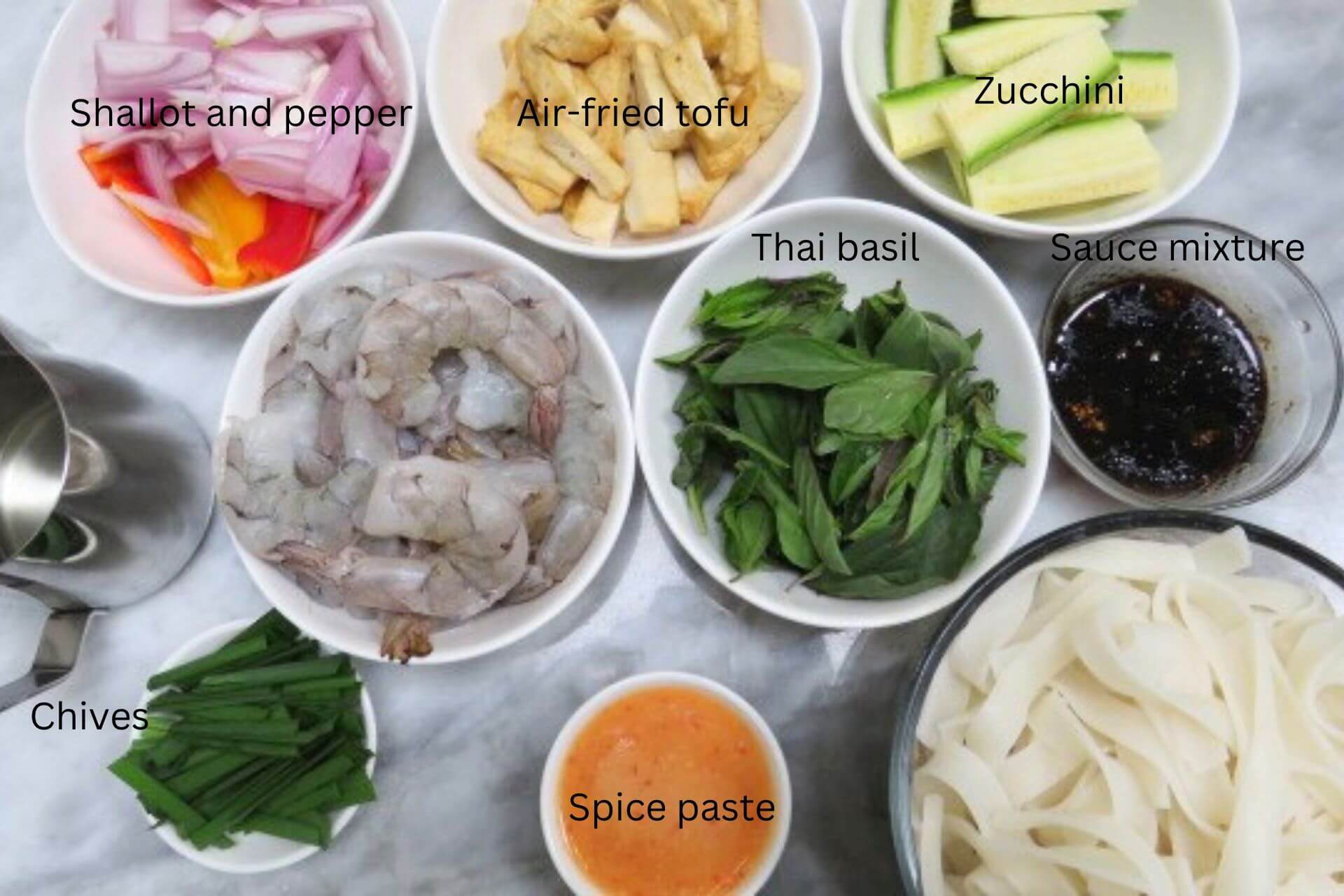
2. Heat the wok until hot, then add a tablespoon of peanut oil. Add the spice paste and sauté for a minute on high heat. Then, add the shrimp and stir-fry for 3-4 minutes or until the shrimp turns from grey to orange. Add the chopped shallot and sauté until tender.

3. Add another tablespoon of oil, and toss in the pepper and zucchini. Stir-fry on high heat for 1-2 minutes. Add the basil leaves, air-fried tofu, and the cooked and drained noodles.
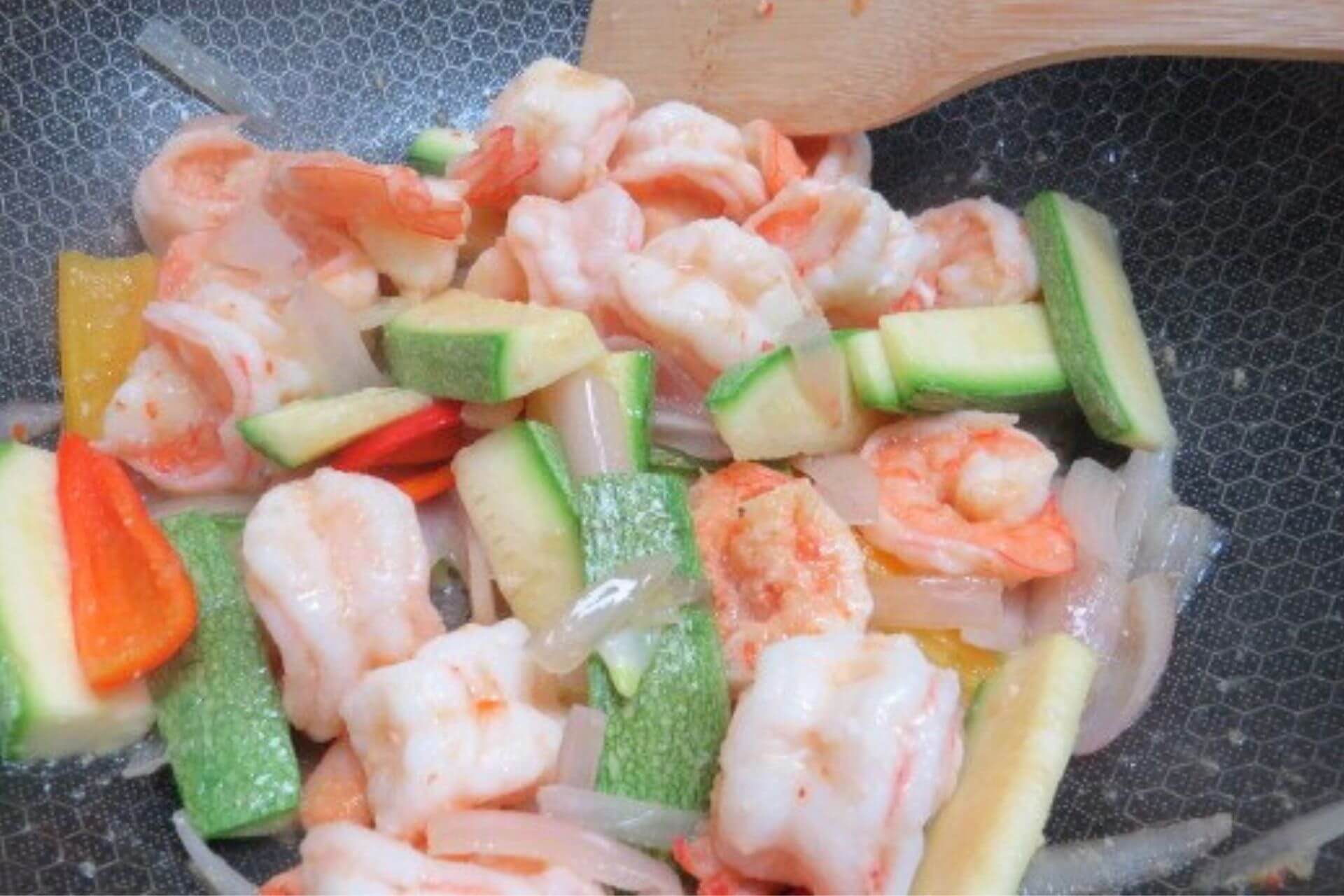
4. Add the sauce mixture and stir-fry for 2 minutes to allow the sauces to coat the noodles and to get a slightly charred effect on the noodles. Serve hot garnished with chives.
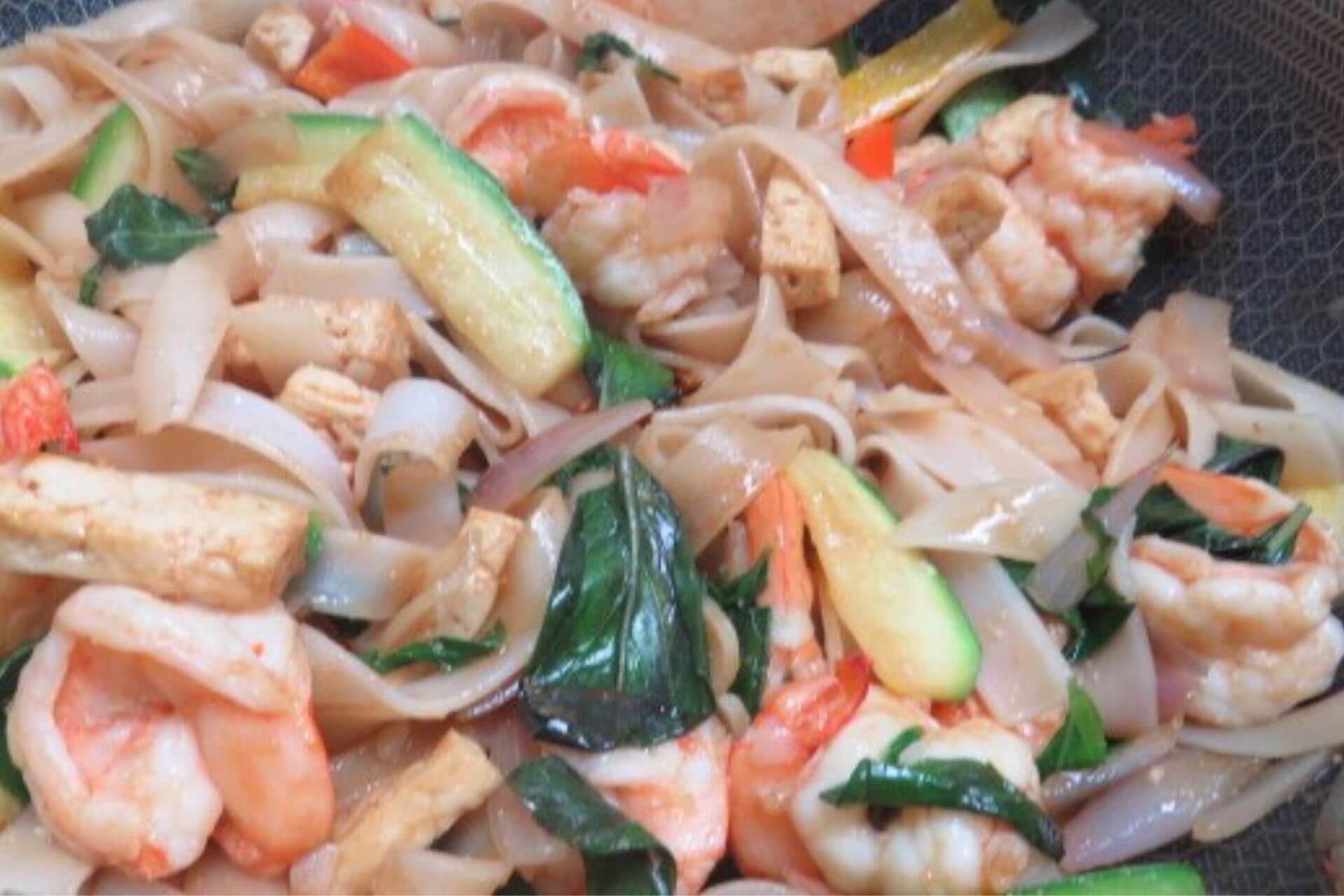
Tips:
1. Scrape the bottom of the wok while tossing and add a tablespoon of water to “clean” the wok and give the noodles a little moisture.
2. Add a few more basil at the end for aroma and flavor.
3. Do not oversoak or overcook the noodles or they will break into pieces while cooking. Try to drain them a few minutes before the recommended time on the instructions (at the al dente stage).
4. Stir-fry the veggies quickly otherwise they will become mushy when overcooked. What you want is crispy veggies in noodles as they will continue cooking in the heat of the cooked noodles.
Serving suggestions:
This recipe for Pad Kee Mao can be served with a Shrimp Lettuce Wrap salad. While reheating it in the microwave, use a lid to lock in the moisture or sprinkle some water when refrying in the wok again. I have gone easy on the sauce, but for those who like it a bit saltier, add more soy sauce at the end.
Storage:
Pad Kee Mao can be refrigerated for a day. You can freeze this noodle dish for three months in airtight containers. As with all fried noodles, frozen Pad Kee Mao must be thawed in the refrigerator and refried again in a wok with a little oil.
Other noodle dishes that you might like:
Pad Kee Mao Recipe
Equipment
- Wok
Ingredients
For the Pad Kee Mao noodles:
- 2 tbsp peanut oil
- ½ pound shrimp deveined
- 3 red chilis deseeded, minced fine
- 1 shallot julienne
- 4 clove garlic chopped
- ½ tbsp galangal peeled, chopped
- 1 pound Thai wide rice noodles dried
- 1 pepper julienne
- 1 zucchini julienne
- 7 oz firm tofu air-fried
- 6 stalk Thai basil
For the sauce:
- 1 tsp fish sauce
- 2 tsp oyster sauce vegetarian
- 2½ tbsp dark soy sauce
- 2½ tbsp soy sauce
- ½ tsp dark brown sugar
- ½ tsp white pepper ground
- ½ tsp sesame chili oil
Instructions
- Prepare the ingredients. Follow the instructions on the package to cook the noodles. Grind the chilis, galangal and garlic to a smooth paste with a teaspoon of water. Mix the ingredients for the sauce in a bowl. Air-fry the julienned tofu for 10 minutes at 375 degrees F.
- Heat the wok until hot, then add a tablespoon of peanut oil. Add the spice paste and sauté for a minute on high heat. Then, add the shrimp and stir-fry for 3-4 minutes or until the shrimp turns from grey to orange. Add the chopped shallot and sauté until tender.
- Add another tablespoon of oil, and toss in the pepper and zucchini. Stir-fry on high heat for 1-2 minutes. Add the basil leaves, air-fried tofu, and the cooked and drained noodles.
- Add the sauce mixture and stir-fry for 2 minutes to allow the sauces to coat the noodles and to get a slightly charred effect on the noodles. Serve hot garnished with chives.
Video
Notes
- Wok must be hot. Use a long spatula so that the spluttering oil will not burn your fingers.
- Add a tablespoon of oil only when the ingredients seem to be sticking to the wok.
- Adjust the seasoning by adding more soy sauce if you like it saltier.
Nutrition


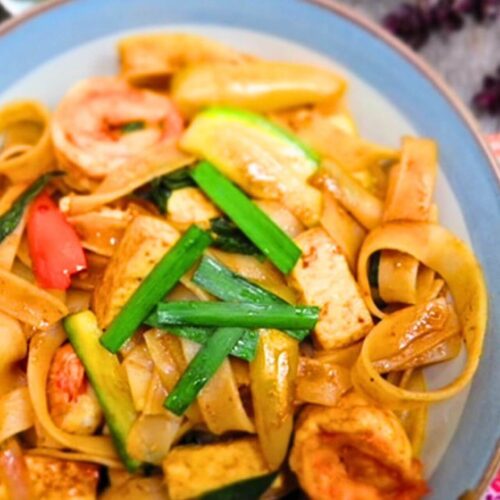
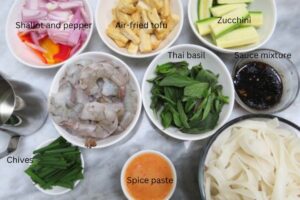
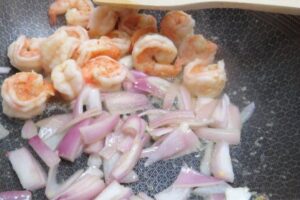
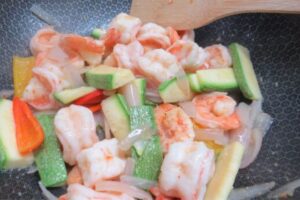
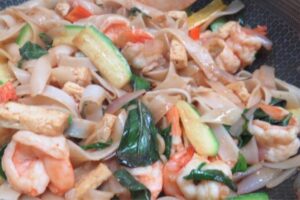





















Thanks for the tips!